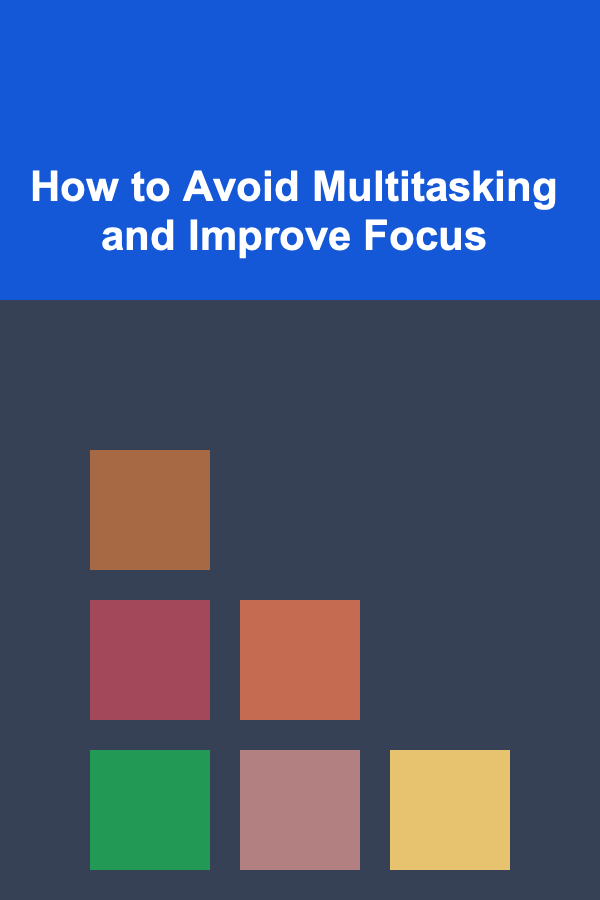
How to Avoid Multitasking and Improve Focus
ebook include PDF & Audio bundle (Micro Guide)
$12.99$10.99
Limited Time Offer! Order within the next:

In our fast-paced, information-driven world, multitasking has become a common practice. People often pride themselves on their ability to juggle multiple tasks simultaneously, believing it enhances productivity. However, research suggests that multitasking can be detrimental to focus, productivity, and overall well-being. This comprehensive guide will explore the pitfalls of multitasking and provide strategies to avoid it, thereby improving focus and efficiency.
Understanding Multitasking
Defining Multitasking
Multitasking refers to the performance of multiple tasks or activities simultaneously. It can involve various forms, such as switching between different tasks (task-switching) or trying to perform two tasks at once (dual-tasking). Common examples include:
- Answering emails while attending a meeting.
- Cooking dinner while watching television.
- Using a smartphone while having a conversation.
The Science Behind Multitasking
Scientific research indicates that humans are not wired to effectively perform multiple tasks at once. Our brains function by focusing on one task at a time, and when we attempt to do more, we experience cognitive overload. According to studies published in journals like Psychological Science, multitasking can lead to decreased efficiency and increased errors.
Common Myths About Multitasking
-
Myth: Multitasking Saves Time
Many believe that doing several tasks at once is time-efficient; however, studies show that multitasking often increases the total time taken to complete tasks.
-
Myth: Multitasking Improves Productivity
While it may seem productive, research suggests that multitasking actually reduces overall productivity due to frequent context-switching.
-
Myth: Multitasking is Necessary for Success
In a competitive work environment, the belief that multitasking is essential for success is pervasive. However, focusing on single tasks often leads to higher quality outcomes.
The Negative Effects of Multitasking
Cognitive Overload
Multitasking can overwhelm cognitive resources, leading to cognitive overload. When the brain is overloaded, it struggles to process information effectively, resulting in decreased comprehension and retention. This overload can also lead to mental fatigue, making it harder to focus on subsequent tasks.
Decreased Productivity
Numerous studies have demonstrated that multitasking can reduce productivity by up to 40%. When people switch tasks frequently, they expend energy and cognitive resources on reorienting themselves instead of making progress. This phenomenon is referred to as "task-switching cost," which diminishes overall work efficiency.
Impact on Mental Health
Constantly juggling multiple tasks can contribute to stress and anxiety. Individuals who multitask frequently report feeling overwhelmed, distracted, and dissatisfied with their work. Long-term exposure to these stressors can lead to burnout, impacting both personal and professional life.
Benefits of Focusing on One Task
Enhanced Productivity
Focusing on a single task allows you to dedicate your full attention and cognitive resources to that particular activity. As a result, tasks are completed more efficiently, leading to a significant increase in overall productivity.
Improved Quality of Work
When you concentrate solely on one task, the likelihood of making mistakes decreases. This focus enhances the quality of your output, whether you're writing, coding, designing, or performing any other task. High-quality work often leads to positive feedback and greater career advancement opportunities.
Greater Satisfaction and Well-Being
Completing tasks without distraction provides a sense of accomplishment and satisfaction. This boost in morale can enhance overall well-being, reducing stress and promoting a healthier work-life balance.
Strategies to Avoid Multitasking
Set Clear Goals
Establishing clear goals for each work session creates a roadmap for your tasks. Break down larger projects into smaller, manageable objectives, allowing you to focus on one aspect at a time.
Tips:
- Use the SMART criteria (Specific, Measurable, Achievable, Relevant, Time-bound) to define your goals.
- Write down your goals and review them regularly to stay on track.
Implement Time Blocking
Time blocking involves scheduling specific blocks of time for focused work on particular tasks. By allocating dedicated time for each task, you ensure that distractions are minimized.
Tips:
- Use a digital calendar or planner to block out time for specific tasks.
- Include breaks in your schedule to recharge and maintain focus.
Utilize the Pomodoro Technique
The Pomodoro Technique is a time management method that involves working in focused intervals (typically 25 minutes), followed by short breaks (5 minutes). After completing four intervals, take a longer break (15-30 minutes).
Tips:
- Use a timer or dedicated app to track your Pomodoros.
- Adjust the lengths of work intervals and breaks based on what works best for you.
Create a Distraction-Free Environment
Your physical environment plays a significant role in your ability to focus. Minimizing distractions can help you concentrate better.
Tips:
- Identify and eliminate potential distractions, such as noise or clutter.
- Create a dedicated workspace that's comfortable and free from interruptions.
Practice Mindfulness
Mindfulness practices, such as meditation or deep breathing exercises, can improve focus and concentration. Developing awareness of your thoughts helps you refocus when distractions arise.
Tips:
- Spend a few minutes daily practicing mindfulness or meditation.
- Incorporate mindful breathing techniques during work sessions to regain focus.
Tools and Techniques for Improved Focus
Task Management Apps
Utilizing task management tools can help organize your tasks and prioritize your workload. These applications enable you to set deadlines, track progress, and manage responsibilities efficiently.
Popular Tools:
- Todoist: A simple yet powerful tool for managing tasks and projects.
- Trello: A visual project management platform that organizes tasks using boards and lists.
- Asana: A comprehensive tool for team collaboration and individual task tracking.
Focus-Enhancing Music and Sounds
Listening to music or ambient sounds can create an atmosphere conducive to focus. Many people find that certain types of music or background noise enhance concentration.
Tips:
- Explore playlists designed for focus on platforms like Spotify or Apple Music.
- Consider using apps that generate white noise or nature sounds.
Digital Minimalism
Adopting digital minimalism involves simplifying your digital life to reduce distractions. This approach encourages intentional use of technology, helping you focus on what truly matters.
Tips:
- Unsubscribe from unnecessary notifications and emails.
- Limit social media usage during work hours.
Overcoming Challenges to Focus
Addressing Internal Distractions
Internal distractions, such as wandering thoughts or worries, can hinder focus. Acknowledging these distractions is the first step toward overcoming them.
Strategies:
- Keep a journal to express your thoughts and concerns, allowing your mind to clear.
- Take short breaks to stretch or walk, providing a mental reset.
Managing External Interruptions
External interruptions, like phone calls or co-worker conversations, can disrupt focus. Implementing boundaries can help minimize these distractions.
Strategies:
- Communicate your need for uninterrupted work time to colleagues or family members.
- Use "Do Not Disturb" features on devices during focused work periods.
Cultivating Patience
Improving focus takes time and practice. Be patient with yourself as you transition away from multitasking habits.
Strategies:
- Set realistic expectations for what you can achieve in a given timeframe.
- Celebrate small wins to build confidence and reinforce positive behaviors.
Real-Life Examples and Case Studies
Case Study: Corporate Environment
A marketing team at a mid-sized corporation struggled with productivity due to constant multitasking. To address this, the team implemented a structured focus strategy:
- Goal Setting: Each week, team members defined specific goals relevant to ongoing projects.
- Time Blocking: Team meetings were scheduled for designated times, allowing for uninterrupted individual work periods.
- Pomodoro Technique: Team members experimented with the Pomodoro Technique, reporting improved focus and reduced stress levels.
As a result, productivity increased by approximately 30%, and the quality of marketing campaigns improved significantly.
Case Study: Creative Process
A freelance graphic designer found herself overwhelmed by client demands, leading to multitasking and diminishing creativity. She adopted a new routine:
- Defined Goals: Each day began with setting clear goals for specific client projects.
- Distraction-Free Workspace: She redesigned her workspace, minimizing clutter and distractions.
- Mindfulness Practices: Incorporating mindfulness exercises in the morning helped her feel centered and focused.
After implementing these changes, the designer reported enhanced creativity and a 50% reduction in project turnaround time.
Conclusion
Avoiding multitasking and improving focus is crucial for maximizing productivity, enhancing the quality of work, and promoting overall well-being. By understanding the detrimental effects of multitasking and implementing effective strategies, individuals can cultivate a focused mindset that leads to long-term success.
Creating a distraction-free environment, utilizing time management techniques, and practicing mindfulness are all essential steps in this journey. Remember that change takes time, and patience is key. Embrace the process, celebrate small victories, and watch as your focus and productivity soar. With commitment and dedication, you can overcome the challenges of multitasking and unlock your full potential.
Reading More From Our Other Websites
- [Home Space Saving 101] How to Maximize Space in Your Entryway with Smart Storage Solutions
- [Screen Printing Tip 101] Best Heat‑Transfer Integration Strategies for Mixed‑Media Screen Printing Designs
- [Organization Tip 101] How to Use a Capsule Wardrobe for Closet Simplification
- [Home Holiday Decoration 101] How to Transform Your Living Room into a Festive Holiday Haven
- [Star Gazing Tip 101] Star-Gazing 2.0: Incorporating Technology and Tradition for a Modern Night-Sky Journey
- [Personal Care Tips 101] How to Create an Eco-Friendly Shower Routine with Body Wash
- [Home Maintenance 101] How to Take Care of Your Home's Insulation for Energy Savings
- [Organization Tip 101] How to Design a Custom Pet Area That Fits Your Lifestyle
- [Horseback Riding Tip 101] From Walk to Trot: Step-by-Step Progressions for New Riders
- [Home Soundproofing 101] How to Build a Home Music Studio with Top Soundproofing Techniques

How to Add a Touch of Luxury to Your Renovation on a Budget
Read More
How to Manage Pet Costs: Budgeting for Pet Care
Read More
How to Organize a Collaborative Hobby Space with Friends
Read More
How to Use Clear Containers for Better Pantry Organization
Read More
How to Use Language Learning Apps to Make Money
Read More
How to Navigate Office Politics as a Marketing Coordinator
Read MoreOther Products

How to Add a Touch of Luxury to Your Renovation on a Budget
Read More
How to Manage Pet Costs: Budgeting for Pet Care
Read More
How to Organize a Collaborative Hobby Space with Friends
Read More
How to Use Clear Containers for Better Pantry Organization
Read More
How to Use Language Learning Apps to Make Money
Read More